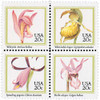
# 2076-79 - 1984 20c Orchids
U.S. #2076-79
1984 20¢ Orchids
- Stamps picture orchids from different regions of the US
- Each stamp includes both the common name and the scientific name
Stamp Category: Commemorative
Set: Orchids
Value: 20¢, rate for first-class mail
First Day of Issue: March 5, 1984
First Day City: Miami, Florida
Quantity Issued: 304,752,000
Printed by: Bureau of Engraving and Printing
Printing Method: Photogravure
Format: Panes of 48 in sheets of 192
Perforations: 11
Why the stamps were issued: Flowers have long been popular stamp subjects around the world. The USPS believed the orchid stamps could be the best-selling commemoratives of 1984. In fact, the orchids were promoted in post offices with signage reading “Collect Beauty; Collect Stamps.”
About the stamp designs: The 1984 Orchid stamps feature paintings by Manabu Saito of four different species of orchids. They picture the pink orchid (Arethusa bulbosa), the Midwestern yellow lady's slipper (Cypripedium calceolus), the spreading pogonia (Cleistes divaricata), and the Pacific calypso (Calypso bulbosa).
First Day City: These stamps were issued in Miami, Florida at the site of the 11th World Orchid Conference.
Unusual fact about these stamps: In promoting the 1984 Orchid stamps, the USPS said each one represented a different region of the US: the wild pink was from Florida, the yellow lady’s slipper from the Midwest, the spreading pogonia from the Northeast and the Pacific calypso from the Pacific coast. Not long after the stamps were issued, botanists such as Allison Cusick pointed out that two of the stamp regions were incorrect. The wild pink doesn’t grow in Florida, and usually found in the Northeast. The spreading pogonia does grow in the Florida and along the Atlantic and Gulf coasts. In spite of this, Cusick applauded the stamps, saying “The orchid flowers are beautifully and accurately depicted; the four species are instantly recognizable. The designs are right. It’s the USPS publicity that was in error.”
History the stamps represent: The lush beauty of orchids has captured the imagination of people for thousands of years. This flower is found all around the world in many different varieties, which has contributed to its enduring popularity.
Orchids have featured prominently in folklore and literature. In one instance, the ancient Greeks believed that a pregnant mother could use orchids to influence the gender of the child. If she ate newer orchids with large tubers, the baby would be a boy. If she ate smaller orchid tubers, it would be a girl. William Shakespeare made reference to orchids, such as in the play Hamlet, when Queen Gertrude compared her son Hamlet’s deranged lover Ophelia to an orchid.
Orchids became a sensation in America and Europe in the 1800s, partly due to the work of prominent horticulturist Sir William Cattley. Cattley developed orchid hybrids from samples he received from South America that became famous for their beauty (and are commonly used in weddings today).
There are approximately 30,000 orchid species. Orchid plants vary from 1/4 inch to 10 feet in height. They grow everywhere except Antarctica, and are most abundant where there’s plenty of rainfall. Most orchids grow on the trunks or branches of trees in warm tropical zones, and on the ground in cooler climates. It’s generally accepted that orchids grow in every color except black, but some gardeners insist even those exist.
U.S. #2076-79
1984 20¢ Orchids
- Stamps picture orchids from different regions of the US
- Each stamp includes both the common name and the scientific name
Stamp Category: Commemorative
Set: Orchids
Value: 20¢, rate for first-class mail
First Day of Issue: March 5, 1984
First Day City: Miami, Florida
Quantity Issued: 304,752,000
Printed by: Bureau of Engraving and Printing
Printing Method: Photogravure
Format: Panes of 48 in sheets of 192
Perforations: 11
Why the stamps were issued: Flowers have long been popular stamp subjects around the world. The USPS believed the orchid stamps could be the best-selling commemoratives of 1984. In fact, the orchids were promoted in post offices with signage reading “Collect Beauty; Collect Stamps.”
About the stamp designs: The 1984 Orchid stamps feature paintings by Manabu Saito of four different species of orchids. They picture the pink orchid (Arethusa bulbosa), the Midwestern yellow lady's slipper (Cypripedium calceolus), the spreading pogonia (Cleistes divaricata), and the Pacific calypso (Calypso bulbosa).
First Day City: These stamps were issued in Miami, Florida at the site of the 11th World Orchid Conference.
Unusual fact about these stamps: In promoting the 1984 Orchid stamps, the USPS said each one represented a different region of the US: the wild pink was from Florida, the yellow lady’s slipper from the Midwest, the spreading pogonia from the Northeast and the Pacific calypso from the Pacific coast. Not long after the stamps were issued, botanists such as Allison Cusick pointed out that two of the stamp regions were incorrect. The wild pink doesn’t grow in Florida, and usually found in the Northeast. The spreading pogonia does grow in the Florida and along the Atlantic and Gulf coasts. In spite of this, Cusick applauded the stamps, saying “The orchid flowers are beautifully and accurately depicted; the four species are instantly recognizable. The designs are right. It’s the USPS publicity that was in error.”
History the stamps represent: The lush beauty of orchids has captured the imagination of people for thousands of years. This flower is found all around the world in many different varieties, which has contributed to its enduring popularity.
Orchids have featured prominently in folklore and literature. In one instance, the ancient Greeks believed that a pregnant mother could use orchids to influence the gender of the child. If she ate newer orchids with large tubers, the baby would be a boy. If she ate smaller orchid tubers, it would be a girl. William Shakespeare made reference to orchids, such as in the play Hamlet, when Queen Gertrude compared her son Hamlet’s deranged lover Ophelia to an orchid.
Orchids became a sensation in America and Europe in the 1800s, partly due to the work of prominent horticulturist Sir William Cattley. Cattley developed orchid hybrids from samples he received from South America that became famous for their beauty (and are commonly used in weddings today).
There are approximately 30,000 orchid species. Orchid plants vary from 1/4 inch to 10 feet in height. They grow everywhere except Antarctica, and are most abundant where there’s plenty of rainfall. Most orchids grow on the trunks or branches of trees in warm tropical zones, and on the ground in cooler climates. It’s generally accepted that orchids grow in every color except black, but some gardeners insist even those exist.
















